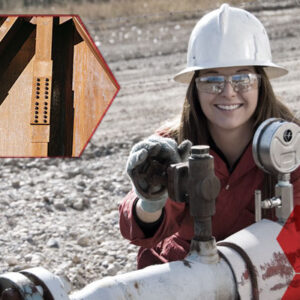Comprehensive Guide to Corrosion Protection for Pipelines
Pipelines are lifelines for transporting substances like water, oil, and gas across vast distances. However, they face a relentless enemy: corrosion. Corrosion eats away at pipelines, threatening their strength and causing expensive repairs or environmental harm. That’s why implementing strong corrosion protection measures is crucial for keeping pipelines safe and sturdy.
What is pipe corrosion
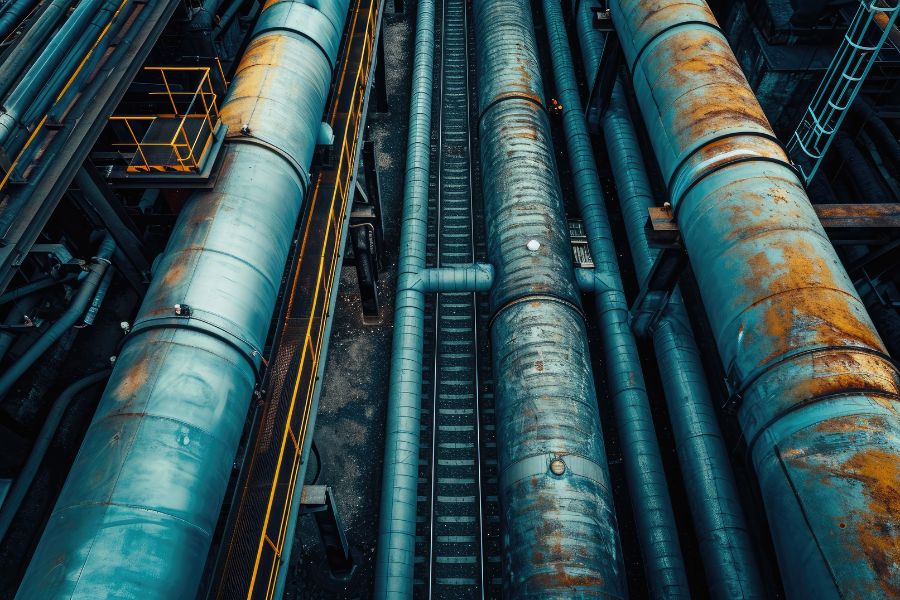
Pipe corrosion is a natural process where metal pipelines slowly wear away over time due to various chemical reactions. It’s a big concern, especially for steel pipes, which are commonly used because they’re strong and durable. When steel pipes come into contact with moisture or other substances like soil or chemicals, they start to rust, weakening the pipes and eventually causing them to fail. This corrosion problem can be worsened by factors like temperature changes, pH levels, and even microbial activity.
To prevent this corrosion and protect pipelines, we need effective corrosion protection for pipelines strategies. By understanding how corrosion happens and what factors contribute to it, we can develop methods to keep our pipelines safe and operational. This is crucial for maintaining the integrity of our infrastructure networks and ensuring they continue to serve us reliably. So, implementing corrosion protection for pipelines is key to preventing costly damage and keeping things running smoothly.
Pipeline Corrosion Detection
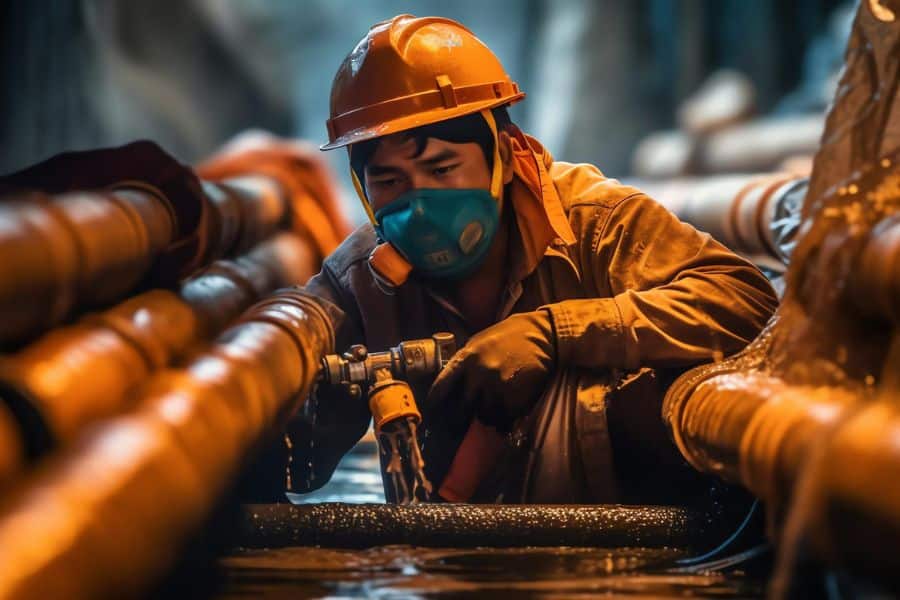
Common Detection Techniques
Visual Inspection: Regular visual checks are like giving pipelines a health check-up. By eyeballing for rust, pitting, or unusual discoloration, we can spot corrosion before it gets out of hand.
Ultrasonic Testing: This fancy-sounding method isn’t as complicated as it seems. It uses sound waves to peek inside pipelines, detecting any hidden corrosion and measuring wall thickness without causing any damage.
Magnetic Flux Leakage (MFL) Inspection: MFL tools are like detectives sniffing out trouble. They detect abnormalities in the magnetic field caused by corrosion or defects in the pipeline.
Electrochemical Techniques: Think of these probes as spies, monitoring corrosion rates by keeping an eye on changes in electrical potential.
In-line Inspection (ILI) or “Smart Pigging”: No, we’re not talking about farm animals here! ILI tools, or smart pigs, travel through pipelines gathering data on wall thickness and spotting any signs of corrosion along the way.
The Importance of Early Detection
Detecting corrosion early is like catching a cold before it turns into pneumonia. It’s crucial because:
Preventing Catastrophic Failures and Leaks: Catching corrosion early prevents small problems from turning into big disasters like leaks or ruptures.
Minimizing Repair Costs and Downtime: Fixing a small corrosion issue is much cheaper and quicker than dealing with a full-blown pipeline emergency.
Extending the Lifespan of the Pipeline: By nipping corrosion in the bud, we can keep pipelines in service for longer, saving money and resources in the long run.
Maintaining Regulatory Compliance and Public Safety: Keeping pipelines in good shape isn’t just about money—it’s about keeping communities safe and following the rules laid down by regulators.
What causes pipe corrosion
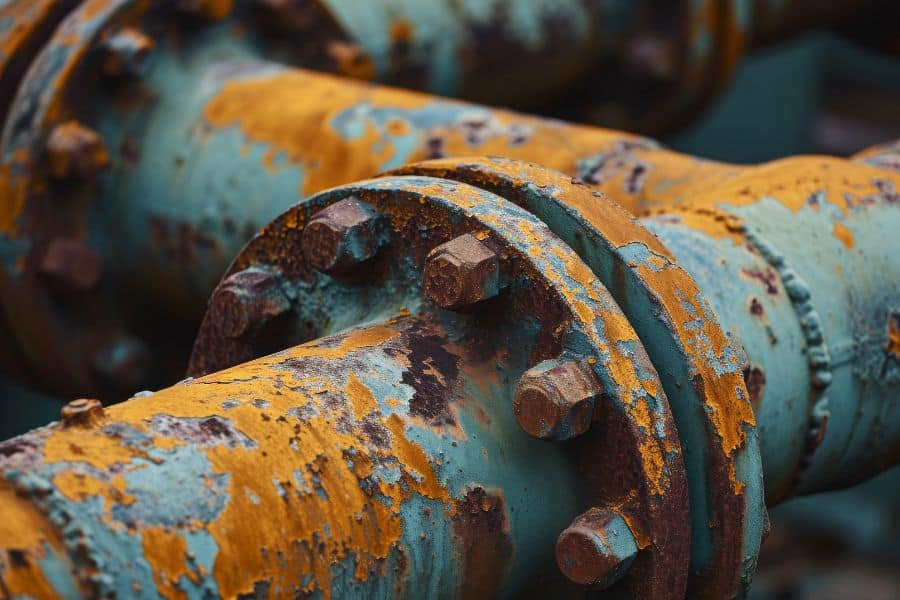
Environmental Factors
Soil Conditions: The type of soil surrounding pipelines, its moisture levels, and pH balance can all impact how quickly corrosion occurs. Certain soils are more corrosive than others, making it essential to implement corrosion protection measures.
Temperature and Climate: Extreme temperatures, high humidity, and prolonged exposure to sunlight can speed up the corrosion process. Protecting pipelines from harsh environmental conditions is key to preventing deterioration.
Atmospheric Conditions: Airborne pollutants, salty sea spray, and industrial emissions can corrode exposed pipelines over time. Shielding pipelines from these corrosive elements is vital for their longevity.
Water Chemistry: The chemistry of water in contact with pipelines also influences corrosion rates. High levels of dissolved oxygen, chlorides, sulfides, or acidity can accelerate corrosion, underscoring the importance of corrosion protection for pipelines that transport water.
Chemical Reactions
Galvanic Corrosion: When dissimilar metals come into contact in the presence of an electrolyte like soil or water, an electrochemical reaction occurs, leading to corrosion of the less noble metal. Implementing corrosion protection for pipelines measures can mitigate the risk of galvanic corrosion.
Corrosion Due to Chemical Substances: Pipelines transporting fluids containing corrosive chemicals or contaminants are susceptible to corrosion. Proper material selection and corrosion protection for pipelines coatings are essential to prevent chemical-induced corrosion.
Microbiologically Influenced Corrosion (MIC): Microorganisms present in soil or water can produce corrosive byproducts that accelerate corrosion. Implementing strategies to inhibit microbial growth and protect pipelines from MIC is crucial for corrosion protection.
Microbial Influences
Bacterial Corrosion: Certain bacteria, such as sulfate-reducing bacteria (SRB), can metabolize organic matter and produce hydrogen sulfide, a corrosive agent. Corrosion protection for pipelines measures can help mitigate the impact of bacterial corrosion on pipelines.
Fungal Corrosion: Fungi and molds can colonize pipeline surfaces, producing organic acids that accelerate corrosion. Regular inspection and maintenance, along with corrosion protection coatings, can help prevent fungal-induced corrosion.
Steel pipe corrosion protection methods

Steel pipes are vital components in various industries, from transporting water and gas to supporting infrastructure projects. However, they are prone to corrosion, which can compromise their integrity over time. Implementing corrosion protection for pipelines is essential to ensure their longevity and safety.
Overview of Protective Measures
Corrosion protection for pipelines involves creating a barrier between the steel pipe surface and corrosive elements present in the environment or the fluids being transported. This is achieved through preventive coatings and cathodic protection systems.
Role of Preventive Coatings
Preventive coatings act as a shield on the external surface of steel pipes, offering a physical barrier against corrosion. These coatings, typically made of materials like epoxy, polyethylene, or fusion-bonded epoxy (FBE), prevent corrosive substances from reaching the steel surface. The thickness and quality of the coating are critical factors determining its effectiveness in corrosion prevention. Before applying the coating, thorough surface preparation, including cleaning and priming, is necessary to ensure proper adhesion and long-term performance.
Utilization of Cathodic Protection Systems
Cathodic protection is an electrochemical technique employed to prevent corrosion by turning the steel pipeline into the cathode of an electrochemical cell. This process can be achieved through impressed current cathodic protection or galvanic cathodic protection using sacrificial anodes made of a more reactive metal. Cathodic protection systems require careful design and ongoing monitoring to maintain adequate protection levels throughout the pipeline’s lifespan.
How many types of corrosion
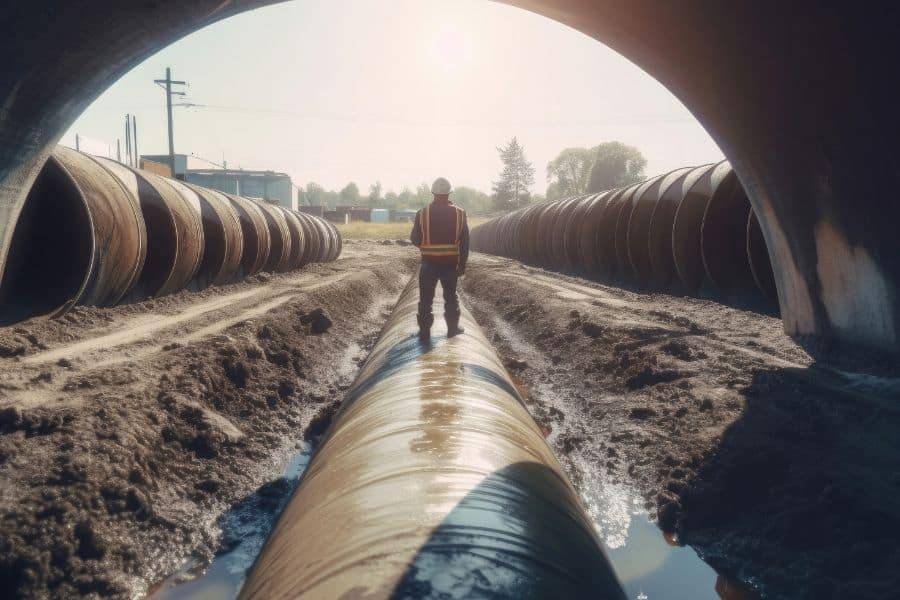
When it comes to ensuring the longevity and reliability of pipelines, understanding the various types of corrosion is crucial. Corrosion protection for pipelines involves strategies tailored to combat different forms of corrosion, including general corrosion, localized corrosion, and environmental cracking.
General Corrosion
General corrosion is like the slow and steady erosion of the pipeline’s surface. It occurs uniformly across the steel pipeline and is often triggered by exposure to moisture, oxygen, and certain chemicals in the environment. To combat this, corrosion protection for pipelines often involves the use of preventive coatings and cathodic protection systems. These coatings act as a shield, blocking corrosive agents from reaching the steel surface.
Localized Corrosion
Imagine tiny, hidden pockets of corrosion gnawing away at specific areas of the pipeline surface – that’s localized corrosion for you. This type of corrosion, which includes pits and crevices, can be especially sneaky as it can lead to rapid deterioration and even pipeline failure. To fend off localized corrosion, corrosion protection strategies often rely heavily on preventive coatings
Environmental Cracking
Picture this: steel pipelines facing the threat of cracking under specific environmental conditions – that’s environmental cracking for you. This category includes nasty culprits like stress corrosion cracking (SCC) and hydrogen-induced cracking (HIC). To shield pipelines from environmental cracking, corrosion protection measures typically start with preventive coatings. These coatings act as a barrier, shielding the steel from corrosive elements and reducing its susceptibility to cracking mechanisms.
Coating in Pipeline
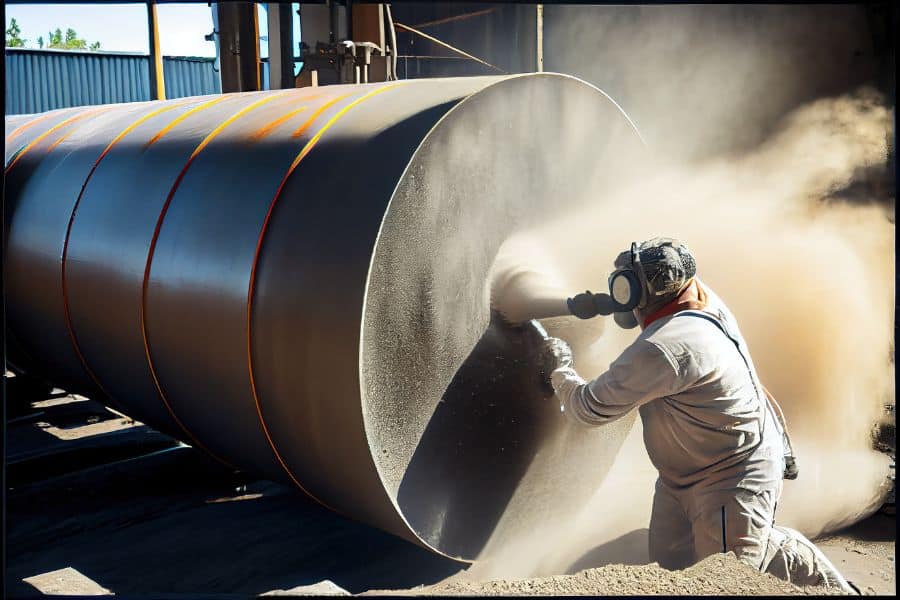
Corrosion protection is vital for pipelines, as they face constant exposure to harsh environments and corrosive substances during operation. One of the most effective methods for safeguarding pipelines is through the application of coatings. These coatings act as a barrier between the metal surface of the pipeline and the surrounding environment, thwarting corrosion protection for pipelines
Purpose and Benefits of Pipeline Coatings:
The primary aim of pipeline coatings is to shield the metal surface from corrosion. Corrosion, a chemical reaction between metal and its environment, can lead to surface degradation and potential pipeline failure. By applying protective coatings, we create a shield against corrosive substances such as water, chemicals, and soil, thus preventing corrosion from taking hold.
In addition to corrosion protection, pipeline coatings offer several other advantages:
Abrasion Resistance: Coatings can also defend against abrasion, which may result from material movement within the pipeline or external forces acting on its surface.
Chemical Resistance: Some coatings are engineered to withstand specific chemicals present in the environment, such as acids or alkalis, providing an added layer of defense.
UV Resistance: Certain coatings guard against the damaging effects of ultraviolet (UV) radiation from sunlight, which can degrade the pipeline surface over time, further bolstering its longevity.
Smooth Surface: Coatings contribute to a smoother pipeline surface, reducing friction and enhancing material flow through the pipeline, thus optimizing operational efficiency.
Types of Coatings Used
Several types of coatings are employed for corrosion protection in pipelines, each with its own distinct properties and applications. Here are some common ones:
Fusion-Bonded Epoxy (FBE): FBE coatings are applied by heating the pipeline surface and spraying it with a powdered epoxy resin. Upon cooling, the resin forms a protective layer, offering excellent corrosion resistance.
Polyethylene (PE): PE coatings are extruded onto the pipeline surface, providing high resistance to corrosion and good flexibility, making them suitable for rugged terrain.
Polypropylene (PP): Similar to PE coatings, PP coatings offer enhanced chemical resistance and are preferred in environments with exposure to corrosive chemicals.
Coal Tar Enamel (CTE): CTE coatings, made from a mixture of coal tar and various additives, offer superb corrosion protection but are less commonly used nowadays due to environmental concerns.
Application Methods
Pipeline coatings can be applied using various methods, depending on the coating type and pipeline requirements:
Spray Application: Certain coatings, like FBE, can be applied using spray equipment, enabling fast and efficient coating application, especially for large-diameter pipelines.
Extrusion: PE and PP coatings are typically applied using extrusion equipment, ensuring uniform coverage and adhesion across the pipeline surface.
Tape Wrapping: For smaller pipelines or repairs, tape wrapping with adhesive-coated tapes forms a continuous corrosion barrier.
Brush or Roller Application: Manual application using brushes or rollers is suitable for touch-ups or areas with limited access.
How does cathodic protection work on pipelines

Pipelines are vital for transporting fluids like water, oil, and gas. But they face a big problem: corrosion. Corrosion can cause leaks, harm the environment, and create safety risks. To fight this, we use cathodic protection systems. In this article, we’ll explore how these systems work and what they involve to keep pipelines safe from corrosion.
Understanding Cathodic Protection Principles
Corrosion protection for pipelines starts with understanding how cathodic protection works. It’s all about electrochemistry. By giving the metal in the pipeline a negative charge, we turn it into the “good guy” in an electrochemical reaction, stopping corrosion in its tracks.
Components of a Cathodic Protection System
Let’s break down a cathodic protection system:
Anodes: These are like the power stations of the system. They can be sacrificial anodes, made of zinc, aluminum, or magnesium, which sacrifice themselves to protect the pipeline. Or they can be impressed current anodes, needing an external power source to do their job.
Cathodic Protection Rectifier: In impressed current systems, this device changes alternating current (AC) into direct current (DC), controlling the flow of electricity to the anodes.
Reference Electrodes: These gadgets measure the difference in potential between the protected metal and a stable reference point. This helps us keep an eye on how well the cathodic protection is working.
Installation and Maintenance Considerations
For corrosion protection for pipelines to be effective, it’s not just about putting the system in place; it’s also about keeping it running smoothly:
Site Survey and Design: Before we start, we need to understand the pipeline’s environment, soil type, coating condition, and any potential interference. This helps us design the right protection plan.
Installation Process: Once we have a plan, we put it into action. This means setting up the anodes, rectifiers, and reference electrodes according to the plan. We have to make sure everything is properly connected and insulated.
Monitoring and Maintenance: We can’t just set it and forget it. Regular checks are vital to make sure the protection is working as it should. This might involve remote monitoring or on-site inspections. If something’s not right, we may need to replace anodes, fix coatings, or adjust the system settings.
By understanding the principles and components of cathodic protection and following proper installation and maintenance practices, we can ensure effective corrosion protection for pipelines, keeping them safe and reliable for years to come.
Closing Insights
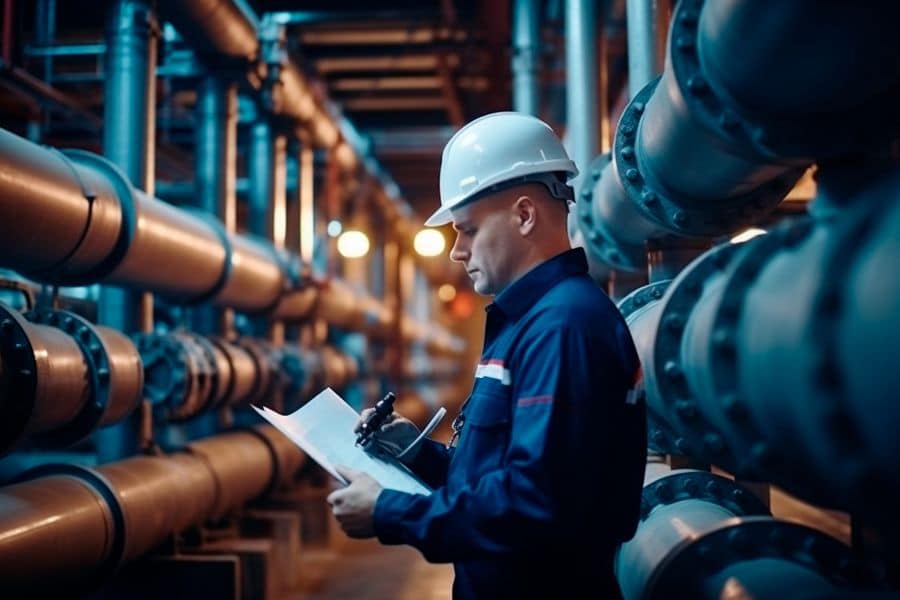
At Corcon – Institute of Corrosion, we understand the critical importance of corrosion protection for pipelines in ensuring their safety and reliability. Through the application of advanced techniques such as coating inspection and cathodic protection systems, pipeline operators can effectively mitigate the damaging effects of corrosion and prolong the lifespan of their infrastructure. Our focus is on preventing corrosion-related incidents and maintaining the structural integrity of pipelines. Through ongoing research and innovation in corrosion protection technologies, we aim to enhance the resilience of pipelines against corrosion challenges continuously. It is our mission to stay at the forefront of corrosion protection for pipelines, ensuring seamless operation and longevity for these vital assets.
FAQs: Frequently Asked Questions
What is pipeline corrosion, and why is it a concern?
A. Pipeline corrosion refers to the deterioration of pipeline materials due to various chemical and electrochemical processes. It is a concern because it can compromise the structural integrity of pipelines, leading to leaks, spills, and potentially hazardous situations.
How is pipeline corrosion detected?
A. Corrosion protection for pipelines can be detected using various techniques, including visual inspection, ultrasonic testing, magnetic flux leakage, and corrosion monitoring sensors. These methods allow for the early detection of corrosion damage, enabling prompt intervention and maintenance.
What are the main causes of pipe corrosion?
A. Pipe corrosion can be caused by environmental factors such as moisture, soil composition, and temperature fluctuations, as well as chemical reactions and microbial activity. Exposure to corrosive substances and mechanical stress can also contribute to corrosion.
What are the primary methods used for protecting steel pipelines from corrosion?
A. Steel pipelines are commonly protected from corrosion using preventive measures such as coatings and cathodic protection systems. Coatings act as a barrier against corrosive elements, while cathodic protection systems provide electrochemical protection by controlling the pipeline’s electrochemical potential.
What are the different types of corrosion that pipelines may experience?
A. Pipelines can experience various types of corrosion, including general corrosion, localized corrosion (such as pitting and crevice corrosion), and environmental cracking (such as stress corrosion cracking and hydrogen-induced cracking). Each type of corrosion protection for pipelines presents unique challenges and requires specific mitigation strategies
Image Reference: Freepik
Disclaimer: All trademarks, logos, and brand names are the property of their respective owners. All company, product, and service names used in this website are for identification purposes only. Use of these names, trademarks, and brands does not imply endorsement

